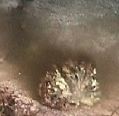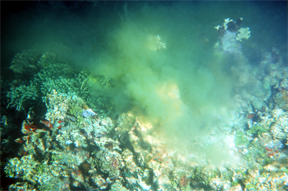|
|
||
|
|
|
||
|

Siphonous green seaweeds (order Byropsidales) are a ubiquitous and ecologically important feature of tropical marine communities worldwide. As food, shelter, and an important source of competition for space, these algae play a vital ecological role within coral reef, lagoon, mangrove swamp, and seagrass habitats. Despite their obvious relevance to reef ecology, however, the biology of this group remains poorly understood.

A wide angle (3 m across photo) shot of gamete release by Caulerpa racemosa on a reef in Panama
These simple observations (coupled with an on-going fish study that demanded my presence on the reef every morning for two and a half years) prompted what has now become a systematic, multi-faceted study of these algae and their reproductive tactics. The results to-date reveal highly synchronized, species-specific patterns of early-morning gamete release by at least 28 species within five genera. The timing and intensity of these bouts of reproduction indicate that seaweed sex plays a previously unappreciated role in the ecology of these tropical populations of green algae. Additionally, the temporal partitioning of "spawning" events among the most closely related species within a clade imply levels of intraspecific reproductive isolation that may contribute to the specious nature of these genera. Relative gamete size, motility, and behavior also varies between species, suggesting a range of reproductive tactics. Within dioecious species, the release by males of micro-gametes occurs several minutes before females release their macro-gametes. All told, this suite of algal reproductive tactics compares and contrasts intriguingly with the mass spawning behavior of other benthic marine organisms, such as corals, gorgonians, and urchins. The study of these remarkable seaweeds has received support from the National Science Foundation, the National Geographic Society, and the Smithsonian's Tropical Research Institute.
Popular reports on this work:Clifton, K.E. 2008. Spatial patterns of reproductive synchrony by four genera of tropical green seaweed across a latitudinal gradient in the Caribbean. Proc. 11th Int. Coral Reef Symp. 1:351-355
Guest, J.R., Baird, A.H., Clifton, K.E. & Heyward, A.J., 2008. From molecules to moonbeams: Spawning synchrony in coral reef organisms. Invert. Reprod. Develop. 51(3):145-149.
Clifton, K.E. & Clifton, L.M. 1999 The phenology of sexual reproduction by tropical green algae. J. Phycol 35:24-34.
Clifton, K.E. 1997 Mass spawning by green algae on coral reefs. Science.275: 1113-1116.
Science News 3/1/97; Earth Magazine: 8/1/97; Dive Training: 1/1/99